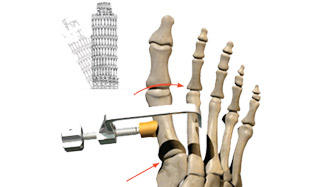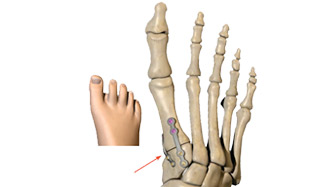At Casper Orthopedics, we understand that bunions can be painful and that they can keep you from enjoying the activities you love. That’s why fellowship-trained foot and ankle specialist Dr. Eric Linford offers Lapiplasty 3D Bunion Correction to help patients with bunions redefine their limits and get back to enjoying an active, healthy lifestyle.
What Is Lapiplasty 3D Bunion Correction?
Lapiplasty 3D Bunion Correction is a surgical procedure that addresses the bunion in three dimensions to correct the source of the problem—the unstable joint. This patented procedure uses advanced fixation technology to secure the correction in place, which allows patients to walk just days after surgery.1
To learn more about Lapiplasty 3D Bunion Correction and how it differs from traditional surgery, watch the video below.
Why Is Traditional Surgery Less Effective?
Traditional bunion surgery uses a two-dimensional approach for a three-dimensional problem. During this procedure, the bone is cut in half and the top part is pushed over to reduce the appearance of the bump. This primarily addresses the symptoms of the bunion, not the source of the problem: the unstable joint. Because of this, most people who undergo traditional surgery have their bunions come back to some degree.3
Additionally, traditional bunion procedures are less effective because:
- 87% of bunions are misaligned in three dimensions2
- The bunion is 12x more likely to come back because the three-dimensional problem is not addressed3
- 1 in 3 patients are dissatisfied with traditional results4
- Up to 70% of bunion patients have their bunions return over time4
How Does Lapiplasty 3D Bunion Correction Work?
Unlike traditional bunion surgery, where the bone is cut and shifted over, the Lapiplasty 3D Bunion Correction procedure uses instruments that have been specifically designed to rotate the bone back to its normal position. This naturally straightens the toe, removes the bump, and provides pain relief. Titanium plating technology is then used to secure the unstable foundation, fixing the source of the problem.5,6
Titanium Plating Technology—Allowing Early Weight-Bearing
The Lapiplasty 3D Bunion Correction procedure uses two small, anatomically-shaped titanium plates to secure the once unstable foundation of the bunion. The support this provides on multiple planes allows patients to walk just a few days after surgery.1 This procedure also utilizes two plates instead of one for a similar reason why a basketball player holds the ball with two hands: it is more secure.


Recovery Comparison: Expectations
Lapiplasty 3D Bunion Correction
- No casting is needed
- Patients are able to bear weight on their foot within days of surgery*
- Walking in a surgical boot for 6 weeks
- At 6 – 8 weeks, patients can go back to wearing tennis shoes
- Patients are able to walk up to 6 – 8 weeks earlier than traditional surgery
*Smith B, et al. 2017 AOFAS Annual Meeting, Seattle, WA.
Traditional Lapidus Surgery
- A cast is required with crutches or a scooter
- Patients are not able to bear weight on their foot following surgery**
- Completely off the foot for 6 weeks
- At 6 – 8 weeks, patients are walking in a surgical boot
- At 12 – 16 weeks, patients can go back to wearing tennis shoes
- Patients are 6 – 8 weeks behind Lapiplasty 3D Bunion Correction patients
**Catanzariti, AR, et al. Jml Foot Ankle Surgery, 38:325-32
Frequently Asked Questions
Below are some questions that are commonly asked by patients as well as their answers:
How long will it take to recover from the Lapiplasty 3D Bunion Correction procedure?
After surgery, patients are usually walking within a few days. Most patients are able to return to work within a few days to a couple of weeks with the use of a surgical boot. Around six weeks, patients can expect to be back to walking in comfortable shoes, such as tennis shoes. However, high-impact activities should not be resumed for three to four months. After four months, patients should be able to return to most activities as well as wear other shoes.9
Will I still be able to wear fashionable shoes?
With the Lapiplasty 3D Bunion Correction procedure, most patients will be able to return to their choice of shoes. However, please note that some shoes can bring pain, even for people with normal feet.
Will I still be able to participate in sports after my Lapiplasty 3D Bunion Correction procedure?
Yes, the Lapiplasty 3D Bunion Correction procedure has no permanent activity limitations once you have fully recovered. Most patients are able to return to the activities they enjoy once the bones are fully healed around four months.9
Can this procedure be performed on someone who previously had traditional surgery?
Yes, the Lapiplasty 3D Bunion Correction procedure is an option that can be used when a revision is required. Patients that have previously been treated will still be able to experience the same benefits from the procedure.
I’ve heard the term “reproducible” used when describing this procedure. What does that mean?
Reproducible means that this procedure can easily be repeated and the outcome will be similar. Since this procedure utilizes special, patented instruments, the guesswork is taken out, which allows for repeatable results.
Is the Lapiplasty 3D Bunion Correction procedure an outpatient procedure, and how long does it last?
Yes, the Lapiplasty 3D Bunion Correction procedure is performed on an outpatient basis. This procedure usually lasts just under an hour. However, if any additional surgeries are being performed by your surgeon during this procedure, the time may increase.
To learn more about Lapiplasty 3D Bunion Correction or to schedule an appointment with Dr. Linford, please call (307) 265-7205 or request an appointment online.
References
- Smith B, Santrock R, Dayton P, Hatch D. Immediate Weight Bearing after Biplanar Plantar Fixation of Lapidus: A Multi-Centered Study. 2017 AOFAS Annual Meeting, Seattle, WA.
- Kim Y, Kim JS, Young KW, et al. Foot Ankle Int. 2015. 36:944-52.
- Okuda R, Kinoshita M, Yasuda T, et al. JBJS. 2007. 89:2163-72.
- Jeuken RM, et al. Foot Ankle Int. 2016. 37:687-95.
- Dayton P, Ferguson J, Hatch D, Santrock R, Scanlan S, Smith B. 2016. Comparison of the Mechanical Characteristics of a Universal Small Biplane Plating Technique Without Compression Screw and Single Anatomic Plate With Compression Screw. J Foot Ankle Surg. 55:567-71.
- Dayton P, Ferguson J, Hatch D, Santrock R, Scanlan S, Smith B. Biplanar Plating with an Anatomic Tension-Side Plate for Lapidus Fusion: Improved Biomechanical Properties. Accepted for presentation at 2017 AOFAS Annual Meeting, Seattle, WA. Submitted for publication.
- Dayton P, Ferguson J, Hatch D, et al.. J Foot Ankle Surg. 2016. 55:567-71.
- Catanzariti, AR, et al. Jrnl Foot Ankle Surgery, 38:325-32.
- MacMahon, A, et al. Foot Ankle Int. 2016. 37: 378-85.